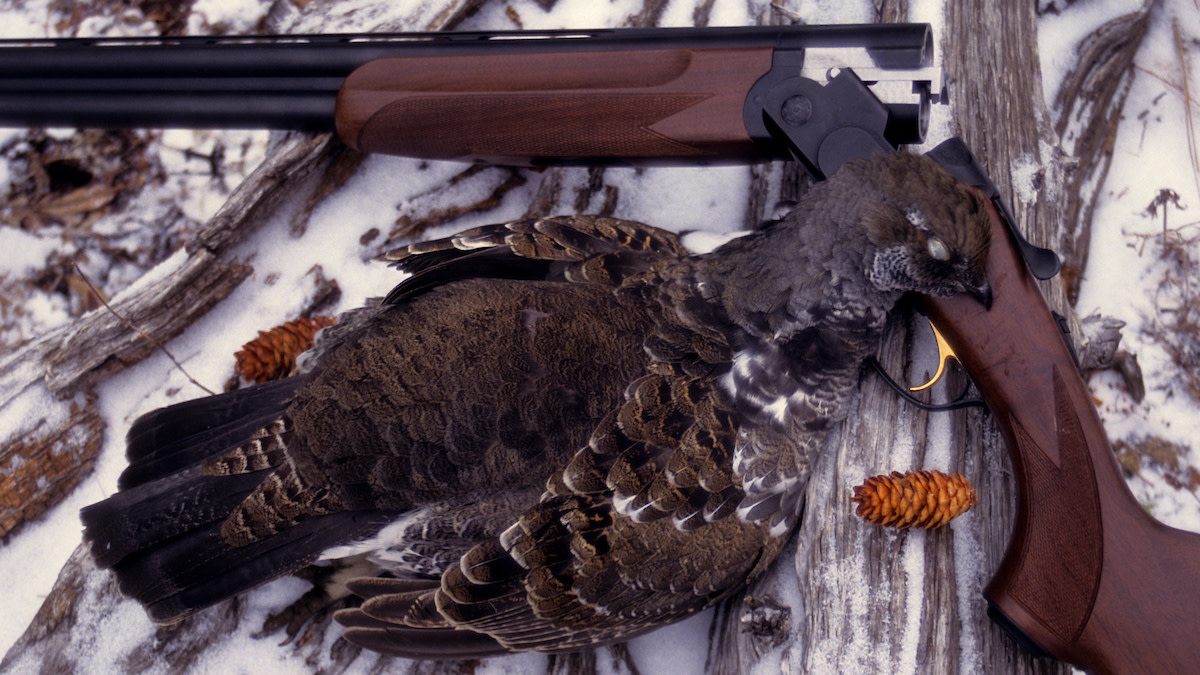
We’ve all seen the magazine covers: A thin creek trickling beneath a grove of aspen, the grouse flushing toward their crowns, a tweeded hunter with a double gun, and the setter pointing the ground where the bird just burst from.
Like most magazine covers, that’s not how it usually happens. It’s a fantasy. For those of us without the income, allergy resistance, or space for a dog, that picturesque scene seems about as reachable as stalking wildebeest on the moon.
But still, without a trained bird dog, hunting and killing grouse is possible, and in some cases even better. From the Appalachians to the Rockies, grouse have common needs: roosts, food, and water. Identify the places where these birds frequent and you’re halfway there. Remember that every grouse you see on your hike that sits in the middle of the trail knows you don’t have a gun. Things tend to change when you put on the blaze orange.
Go Early
Go early in terms of the season and the day. The earlier in the season you hunt, the more birds you’ll find. With so many leaves still on the trees, the extra cover makes birds feel safer. While walking through heavy undergrowth, move slowly and take your time looking for birds that will stay still until the danger passes. Move your head up and down and side to side to shift perspective. Sometimes all you’ll see is the flick of a tail, or a small head turning. Grouse are small, so look small. Rely on your ears as well. Stop and listen to grouse running away or “peeping” as they do when they get nervous.
While some hunters will cringe at the idea of hunting birds so close to the opener (a few western states start their grouse seasons on September 1st) when young still haven’t even fully molted, I believe that the decerning hunter should be able to recognize young because they stalk closer to the birds with the advantage of foliage. Birds grow fast, let the young and mother fly into next month.
Also, set your alarm before sunrise. Without the aid of a dog, you’ll want to hunt grouse when they’re at their most active: in the morning when they come off their roost to feed.
When temperatures still reach the 70s by the afternoon, be walking through grouse cover when the temperatures are in the 40s and 50s. Grouse will head back to shade once their crop is full and that window shrinks in the heat. As the days grow colder, the grouse will want to feed when the sun can warm them. If it dropped into the 30s the night before, they’ll wait until the mid-40s to start pecking.
Hunt ‘The Zone’
It may seem that grouse are just out in the woods, randomly scattered throughout the mountain and timber. Without a dog telling you where to go it must just be blind luck to stumble into one.
Understanding that certain species will be in specific environments is key. You’ll find spruce grouse in spruce forests, dusky and sooty in huckleberry fields and high mountain grass parks, and ruffed grouse along creeks.
When I first started hunting grouse, I’d walk logging roads for miles and turn up enough birds to keep things interesting, but once I realized what they wanted in terms of cover, my flush rates jumped drastically.
Like so much wildlife, grouse love edges; the edges of clear-cuts, creek bottoms, mountain meadows, lake shores, rock outcroppings, and coniferous or deciduous transition areas. The longer I can keep myself in edge habitats, the more birds I see. Creeks are excellent for sustained hunting and traveling, but ridgelines also offer this habitat. Spending more time in the most likely cover will provide more birds. Just like having your fly in the water longer will likely give you more trout.
Be Ready
This is easier said than done. After not flushing a bird for 20 or 30 minutes, you can begin to think you’re on a hike rather than hunting. It can be exhausting to stay ready every second of the hunt (and no one does) but it’s important to continuously remind yourself to have your thumb on the safety and gun in a position that you’re ready to swing. Grouse are notorious for catching people off guard, and you need to be ready when they show themselves.
This tip is more mental than physical. Remaining present and focused on the task at hand is the best way to prepare for a bird that wants to disappear. But you can still practice with your finger off the trigger and safety on. In thick cover, bring your shotgun to your cheek while walking and swing as if you were following a bird. While you obviously don’t have the explosion of wings frazzling your nerves, this is how you build muscle memory.
Muscle memory is what will take over when the grouse flushes from the alder thicket, and without realizing it, you swing and pull the trigger, watching the bird fall. And in that moment, it feels a bit like a fantasy.
Feature image via Tosh Brown.






Conversation